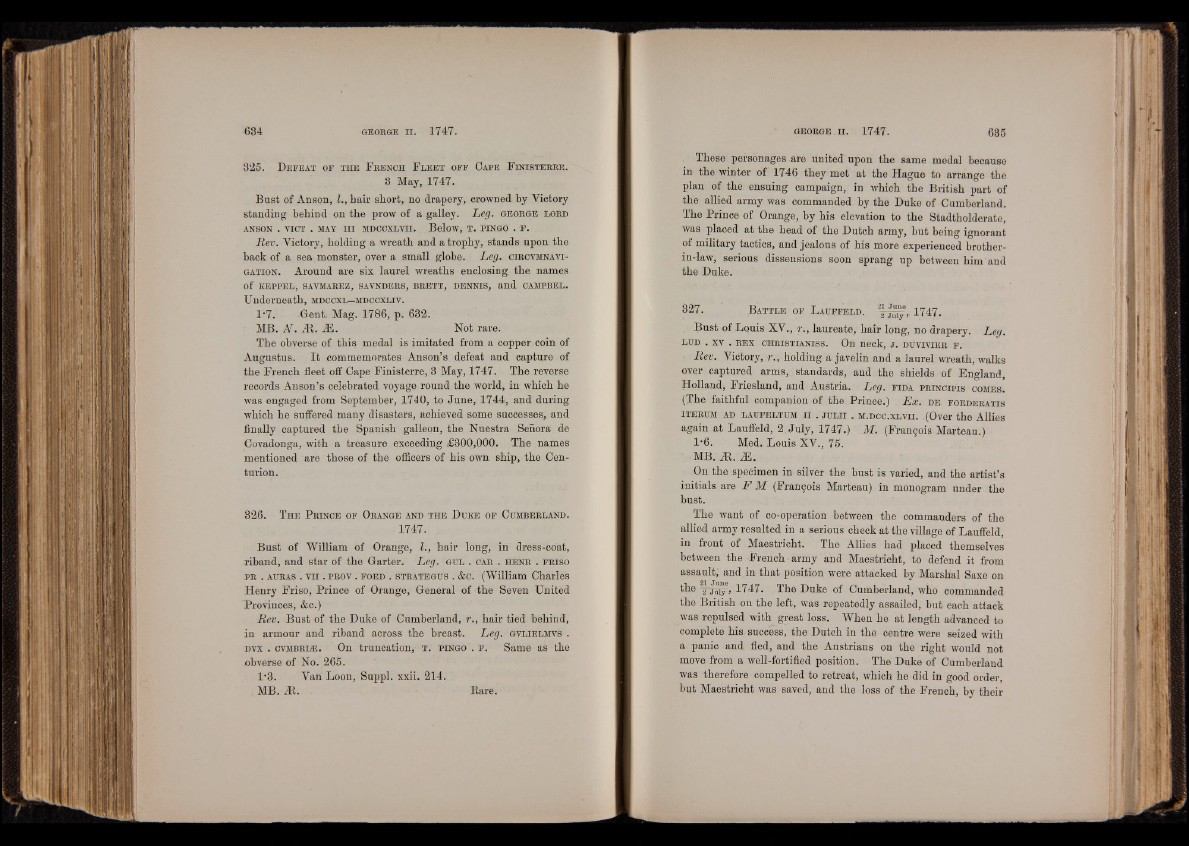
8 2 5 . D e f e a t o f t h e F e e n c h F l e e t o f f Ca p e F in i s t e b e e .
3 May, 1747.
Bust of Anson, I., bair short, no drapery, crowned by Victory
standing behind on the prow of a galley. Leg. g e o b g e lo e d
ANSON . VICT . MAY I I I MDCCXLVII. Below, T. PINGO . F.
Rev. Victory, holding a wreath and atrophy, stands upon the
back of a sea monster, over a small globe. Leg. c ib cvm n a v i-
g a t io n . Around are six laurel wreaths enclosing the names
of k e p p e l , sa vm a be z , sa v n d e b s , b e e t t , d e n n is , and CAMPBEL.
Underneath, mdccxl—mdc c x l iv .
1-7. Gent. Mag. 1786, p. 632.
MB. ¡¡¡g iR. AE. Not rare.
The obverse of this medal is imitated from a copper coin of
Augustus. It commemorates Anson’s defeat and capture of
the French fleet off Cape Finisterre, 3 May, 1747. The reverse
records Anson’s celebrated voyage round the world, in which he
was engaged from September, 1740, to June, 1744, and during
which he suffered many disasters, achieved some successes, and
finally captured the Spanish galleon, the Nuestra Señora de
Covadonga, with a treasure exceeding ¿6300,000. The names
mentioned are those of the officers of his own ship, the Centurion.
326. T h e P e in c e o f Oea n g e and t h e D u k e o f C um b e b l a n d .
1747.
Bust of William of Orange, I., hair long, in dress-coat,
riband, and star of the Garter. Leg. g u l . c a b . h e n b . f b i s o
p e . a u e a s . v i i . p e o v . f o e d . STEATEGUS . &c. (William Charles
Henry Friso, Prince of Orange, General of the Seven United
Provinces, &c.)
Rev. Bust of the Duke of Cumberland, r., hair tied behind,
in armour and riband across the breast. Leg. g v l ie lm v s .
dvx . cvMBB Lffi. On truncation, t . p in g o . f . Same as the
obverse of No. 265.
1'3. Van Loon, Suppl. xxii. 214.
, MB. At. Rare.
These personages are united upon the same medal because
in the winter of 1746 they met at the Hague to arrange the
plan of the ensuing campaign, in which the British part of
the allied army was commanded by the Duke of Cumberland.
The Prince of Orange, by his elevation to the Stadtholderate,
was placed at the head of the Dutch army, but being ignorant
of military tactics, and jealous of his more experienced brother-
in-law, serious dissensions soon sprang up between him and
the Duke.
327. B a t t l e o f L a u f f e l d . 1747.
. Bust of Louis XV., r., laureate, hair long, no drapery. Leg.
lu d . xv . e e x c h b is t ia n is s . On neck, j . d u v iv ie b f .
• Rev. Victory, r., holding a javelin and a laurel wreath, walks
over captured arms, standards, and the shields of England,
Holland, Friesland, and Austria. Leg. f id a p e in c i p i s c om e s .
(The faithful companion of the Prince.) Ex. d e , f o e d e e a t is
it e e u m AD LAUFELTUM i i . j u L i i . M.D Cc.xL vn. .(Over the Allies
again at Lauffeld, 2. July, 1747.) M. (François Marteau.)
1-6. Med. Louis XV., 75.
MB. JR. Æ.
On the specimen in silver the bust is varied, and the artist’s
initials are F M (François Marteau) in monogram under the
bust.
The want of co-operation between the commanders of the
allied army resulted in a serious check at the village of Lauffeld,
in front of Maestricht. The Allies had placed themselves
between the French ■ army and Maestricht, to defend it from
assault, and in that position were attacked by Marshal Saxe on
a jiiiy > 1747. The Duke of Cumberland, who commanded
the British on the left, was repeatedly assailed, but each attack
was repulsed with great loss. When he at length advanced to
complete his. suceess, the Dutch in the centre were seized with
a panic and fled, and the Austrians on the right would not
move from a well-fortified position. The Duke of Cumberland
was therefore compelled to retreat, which he did in good order,
but Maestricht was saved, and the loss of the French, by their